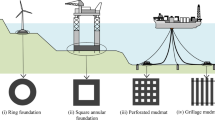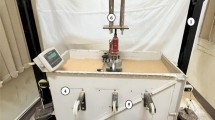Abstract
Constructing infrastructures such as traffic and railway gantries, transmission towers, and near-shore sea walls on soft soils, demands specially designed foundation systems capable of withstanding pull-out forces. Plate anchors are crafted for such environments. It consists of a steel plate embedded in the soil and connected to the external structure through a tie-rod. These anchors have become increasingly prevalent in engineering projects designed to withstand the pull-out forces from the superstructure. The present study investigates the vertical pull-out response of embedded anchors, subjected to cyclic disturbances, using three-dimensional finite element analysis. Advanced constitutive models, including the Soft Soil (SS) model and Hardening Soil model with small-strain stiffness (HSsmall), are employed to study the non-linear and time-dependent response of soils under monotonic and cyclic pull-out loads. The numerical analysis indicates that, in addition to soil type and anchor size, the placement and nature of loading, influence the anchor capacity. It was noted that under cyclic loads, anchors buried in saturated soft soils display a non-linear hysteresis response and a degradation in pull-out resistance with loading cycles. This reduction in anchor resistance with an increment in the loading cycle is noted when the anchor is subjected to higher cyclic stresses. A series of numerical investigations were carried out to analyse the impact of reinforcing the soil above the anchor with geotextile. This approach aimed to address the challenges associated with soft soils and enhance the performance of anchor-soil foundation systems under different loading scenarios. The results highlight the substantial role of geotextile reinforcement in enhancing anchor stability and resistance against vertical pull-out and cyclic disturbances. Reinforcing the soil above the anchor plate amplifies the pull-out resistance up to 45%, in contrast to anchors placed in unreinforced soil. In addition, the anchors exhibit improved performance under cyclic loads, with an enhancement in cyclic pull-out resistance up to 29%, without causing additional degradation of the soil’s shear strength under repeated cyclic loading. This improvement in cyclic pull-out resistance is attributed to the resilient cyclic characteristics of geotextile reinforcement.


























Similar content being viewed by others
Data Availability
The data supporting the findings of this research are available from the corresponding author (RaviShankar Subramaniam, at sravishankariitm@gmail.com) upon reasonable request.
References
Das B, Shukla S (2013) Earth anchors, 2nd edn. J. Ross Publishing, Florida
Meyerhof GG, Adams JI (1968) The ultimate uplift capacity of foundations. Can Geotech J 5(4):225–244. https://doi.org/10.1139/t68-024
Davie JR, Sutherland HB (1977) Uplift resistance of cohesive soils. J Geotech Eng Div ASCE 103(9):935–952. https://doi.org/10.1061/AJGEB6.0000491
Das BM (1978) Model tests for the uplift capacity of foundations in clay. Soil Found 18(2):17–24
Das BM (1980) A procedure for estimation of ultimate capacity of foundations in clay. Soil Found 20(1):77–82. https://doi.org/10.3208/sandf1972.20.77
Das BM, Puri VK (1989) Holding capacity of inclined square plate anchors in clay. Soil Found 29(3):138–144. https://doi.org/10.3208/sandf1972.29.3_138
Das BM, Singh G (1994) Uplift capacity of plate anchors in clay. In: Proceedings of the 4th international offshore and polar engineering conference, vol. 1 ISOPE, London, pp. 436–442
Choudhary AK, Pandit B, Babu GLS (2018) Three-dimensional analysis of uplift behaviour of square horizontal anchor plate in frictional soil. Int J Geosynth Ground Eng. https://doi.org/10.1007/s40891-018-0130-1
Aliasgharzadeh M, Yousefzadehfard M, Atrchian M et al (2023) Experimental study on pull-out capacity of geocell and geotextile-reinforced horizontal plate anchors embedded in granular soil. Int J Geosynth Ground Eng. https://doi.org/10.1007/s40891-023-00428-z
Singh SP, Ramaswamy SV (2008) Effect of shape on holding capacity of plate anchors buried in soft soil. Geomech Geoengin 3(2):157–166. https://doi.org/10.1080/17486020802126875
Rowe RK, Davis EH (1982) The behaviour of anchor plates in clay. Géotechnique 32(1):9–23. https://doi.org/10.1680/geot.1982.32.1.9
Merifield RS, Sloan SW, Yu HS (2001) Stability of plate anchors in undrained clay. Géotechnique 51(2):141–154. https://doi.org/10.1680/geot.2001.51.2.141
Merifield RS, Lyamin AV, Sloan SW, Yu HS (2003) Three dimensional lower bound solutions for the stability of plate anchors in clay. J Geotech Geoenviron Eng 129(3):243–253. https://doi.org/10.1061/(ASCE)1090-0241(2003)129:3(243)
Ganesh R, Sahoo JP (2017) Vertical uplift resistance of plate anchors with the fluctuations of groundwater table. Int J Geosynth Ground Eng. https://doi.org/10.1007/s40891-017-0084-8
Song Z, Hu Y, Randolph MF (2008) Numerical simulation of vertical pull-out of plate anchors in clay. J Geotech Geoenviron Eng ASCE 134(6):866–875. https://doi.org/10.1061/(ASCE)1090-0241(2008)134:6(866)
Wang D, Hu Y, Randolph MF (2010) Three-dimensional large deformation finite-element analysis of plate anchors in uniform clay. J Geotech Geoenviron Eng ASCE 136(2):355–365
Maitra S, White D, Chatterjee S, Choudhury D (2019) Numerical modelling of seepage and tension beneath plate anchors. Comput Geotech 108:131–142. https://doi.org/10.1016/j.compgeo.2018.12.022
Zhang N, Wu H, Shen JS, Hino T, Yin Z (2016) Evaluation of the uplift behaviour of plate anchor in structured marine clay. Mar Georesour Geotechnol 35(6):1–11. https://doi.org/10.1080/1064119X.2016.1240273
Singh SP, Tripathy DP, Ramaswamy SV (2007) Estimation of uplift capacity of rapidly loaded plate anchors in soft clay. Mar Georesour Geotechnol 25(3):237–249. https://doi.org/10.1080/10641190701699376
Ravishankar S, Banerjee S, Sarvesh, and Mukherjee, S. (2022) Static, cyclic and post-cyclic pull-out response of horizontal plate anchors in reinforced soft clay. Int J Geosynth Ground Eng. https://doi.org/10.1007/s40891-022-00381-3
Yu L, Liu J, Kong XJ, Hu Y (2011) Numerical study on plate anchor stability in clay. Geotechnique 61(3):235–246. https://doi.org/10.1680/geot.8.P.071
Ponniah DA, Finlay TW (1983) Cyclic behaviour of plate anchors. Can Geotechn J 25:374–381. https://doi.org/10.1139/t88-038
Rao SN, Prasad SN (1991) Behaviour of a helical anchor under vertical repetitive loading. Mar Geotechnol 10:203–228. https://doi.org/10.1080/10641199109379892
Singh SP, Ramaswamy SV (2008) Influence of frequency on the behaviour of plate anchors subjected to cyclic loading. Marine Georesour Geotechnol 26(1):36–50. https://doi.org/10.1080/10641190801952410
Singh SP, Ramaswamy SV (2010) Effects of cyclic frequency and pre-loading on behaviour of plate anchors. In: Proceedings of the GeoShanghai international conference 2010, deep foundations and geotechnical in situ testing, Shanghai, China. pp. 252–260. https://doi.org/10.1061/41106(379)
Bhattacharya P, Bhowmik D, Mukherjee SP, Chattopadhyay BC (2008) Pull-out behaviour of square anchors in reinforced clay. In: Proceedings of the 12th international conference of the international association for computer methods and advances in geomechanics, vol 1, pp 3441–3447.
Banerjee S, Mahadevuni N (2017) Pull-out behaviour of square anchor plates in reinforced soft clay. Int J Geosynth Ground Eng Springer 3(3):25. https://doi.org/10.1007/s40891-017-0101-y
Biradar J, Banerjee S, Shankar R, Ghosh P, Mukherjee S, Fatahi B (2019) Response of square anchor plates embedded in reinforced soft clay subjected to cyclic loading. Geomech Eng 17(2):165–173. https://doi.org/10.12989/gae.2019.17.2.165
Brinkgreeve RBJ, Shen RF (2011) Structural elements and modelling excavations in Plaxis, Delft
Fourie AB, Fabian KJ (1987) Laboratory determination of clay-geotextile interaction. Geotext Geomembr 6:275–294. https://doi.org/10.1016/0266-1144(87)90009-4
Vermeer PA, Brinkgreve RBJ (1998) PLAXIS version 7 general information manual. Balkema, Rotterdam, pp 3–32
Vermeer PA, Neher HP (1999) A soft soil model that accounts for creep. Beyond 2000 in Computational Geotechnics—Ten years of Plaxis International. Balkema, Rotterdam, pp 249–261
Ardebili ZA, Gabr F, Rahman MS (2015) Uplift Capacity of plate anchors in saturated clays: analyses with different constitutive models. Int J Geomech. https://doi.org/10.1061/(ASCE)GM.1943-5622.0000518
Schanz T, Vermeer PA, Bonnier BG (1999) The hardening soil model: formulation and verification. Beyond 2000 in computational geotechnics—10 years of PLAXIS, Balkema
Benz T, Vermeer PA, Schwab R (2009) A small strain overlay model. Int J Numer Anal Meth Geomech 33(1):25–44. https://doi.org/10.1002/nag.701
Brinkgreve RBJ, Kappert MH, Bonnier PG (2007) Hysteretic damping in small-strain stiffness model. In: Proceedings of the 10th international conference on computer methods and advances in geomechanics, Rhodes, Greece, pp. 737–742. https://doi.org/10.1201/NOE0415440271.ch106
Brinkgreve RBJ, Kumarswamy S, Fonseca F, Swolfs WM, Manoj N (2022) Material models manual, Plaxis 3D. Delft, Netherlands
Brinkgreve RBJ (2005) Selection of soil models and parameters for geotechnical engineering application. In: Soil constitutive models: evaluation, selection, and calibration, geotechnical special publication 128, ACSE, Reston, VA, 69–98. https://doi.org/10.1061/40771(169)4
Banerjee S, Malek S (2020) Assessment of a hyperbolic model for undrained-cyclic shearing of remoulded clay. J Eng Mech 146(7):04020064, 1–15. https://doi.org/10.1061/(ASCE)EM.1943-7889.0001780
Vucetic M, Dobry RE (1991) Effect of soil plasticity on cyclic response. J Geotechn Eng ASCE 117(1):89–107. https://doi.org/10.1061/(ASCE)0733-9410(1991)117:1(89
Vucetic N (1994) Cyclic threshold shear strains in soils. J Geotechn Eng 120(12):2208–2228. https://doi.org/10.1061/(ASCE)0733-9410(1994)120:12(2208)
Yu L, Zhou Q, Liu J (2015) Experimental study on the stability of plate anchors in clay under cyclic loading. Theor Appl Mech Lett 5(2):93–96. https://doi.org/10.1016/j.taml.2015.02.005
Okur DV, Ansal A (2007) Stiffness degradation of natural fine-grained soils during cyclic loading. Soil Dyn Earthq Eng 27:843–854. https://doi.org/10.1016/j.soildyn.2007.01.005
Andersen KH, Pool JH, Brown SF, Rosenbrand WF (1980) Cyclic and static laboratory tests on Drammen clay. J Geotechn Eng Div ASCE 106(GT5):499–529. https://doi.org/10.1061/AJGEB6.0000957
ASTM D4595 (2017) Standard test method for tensile properties of geotextiles by the wide-width method. ASTM International, West Conshohocken, PA
Funding
Partial support for this research was provided by the Department of Science and Technology, India, through project funding [DST Sanction No: SB/S3/CEE/0023/2014]. The financial assistance from DST is gratefully acknowledged.
Author information
Authors and Affiliations
Contributions
Ravishankar Subramaniam: Identification of the problem, methodology, numerical modelling, interpretation of results, and preparation of the manuscript. Subhadeep Banerjee: Conceptualization, guidance, results evaluation, and final manuscript authorization.
Corresponding author
Ethics declarations
Conflict of interest
The authors declare that there are no conflicts of interest related to this publication.
Additional information
Publisher's Note
Springer Nature remains neutral with regard to jurisdictional claims in published maps and institutional affiliations.
Rights and permissions
Springer Nature or its licensor (e.g. a society or other partner) holds exclusive rights to this article under a publishing agreement with the author(s) or other rightsholder(s); author self-archiving of the accepted manuscript version of this article is solely governed by the terms of such publishing agreement and applicable law.
About this article
Cite this article
Subramaniam, R., Banerjee, S. Three-Dimensional Numerical Analysis of Static and Cyclic Pull-out Response of Plate Anchors in Reinforced Soft Clay. Int. J. of Geosynth. and Ground Eng. 10, 46 (2024). https://doi.org/10.1007/s40891-024-00548-0
Received:
Accepted:
Published:
DOI: https://doi.org/10.1007/s40891-024-00548-0




